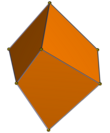Hexahedron
A hexahedron (pl.: hexahedra or hexahedrons) or sexahedron (pl.: sexahedra or sexahedrons) is any polyhedron with six faces. A cube, for example, is a regular hexahedron with all its faces square, and three squares around each vertex.
There are seven topologically distinct convex hexahedra,[1] one of which exists in two mirror image forms. Additional non-convex hexahedra exist, with their number depending on how polyhedra are defined. Two polyhedra are "topologically distinct" if they have intrinsically different arrangements of faces and vertices, such that it is impossible to distort one into the other simply by changing the lengths of edges or the angles between edges or faces.
Convex, Cuboid
[edit]| Quadrilaterally-faced hexahedron (Cuboid) 6 faces, 12 edges, 8 vertices | ||||||
|---|---|---|---|---|---|---|

|

|

|

|

|

|

|
| Cube (square) |
Rectangular cuboid (three pairs of rectangles) |
Trigonal trapezohedron (congruent rhombi) |
Trigonal trapezohedron (congruent quadrilaterals) |
Quadrilateral frustum (apex-truncated square pyramid) |
Parallelepiped (three pairs of parallelograms) |
Rhombohedron (three pairs of rhombi) |
| Oh, [4,3], (*432) order 48 |
D2h, [2,2], (*222) order 8 |
D3d, [2+,6], (2*3) order 12 |
D3, [2,3]+, (223) order 6 |
C4v, [4], (*44) order 8 |
Ci, [2+,2+], (×) order 2 | |
Convex, Others
[edit]| Convex | |||||
|---|---|---|---|---|---|

|
 
|

|

|

|

|
| Triangular bipyramid | Tetragonal antiwedge. Chiral – exists in "left-handed" and "right-handed" mirror image forms. | Pentagonal pyramid | |||
| 36 Faces 9 E, 5 V |
4.4.3.3.3.3 Faces 10 E, 6 V |
4.4.4.4.3.3 Faces 11 E, 7 V |
5.35 Faces 10 E, 6 V |
5.4.4.3.3.3 Faces 11 E, 7 V |
5.5.4.4.3.3 Faces 12 E, 8 V |
Concave
[edit]Three further topologically distinct hexahedra can only be realised as concave acoptic polyhedra. These are defined as the surfaces formed by simple polygon faces with disjoint interiors, with each edge shared by exactly two faces and each vertex surrounded by a cycle of three or more faces.[2]
| Concave | ||
|---|---|---|

|

|

|
| 4.4.3.3.3.3 Faces 10 E, 6 V |
5.5.3.3.3.3 Faces 11 E, 7 V |
6.6.3.3.3.3 Faces 12 E, 8 V |
These cannot be convex because they do not meet the conditions of Steinitz's theorem, which states that convex polyhedra have vertices and edges that form 3-vertex-connected graphs.[3] For other types of polyhedra that allow faces that are not simple polygons, such as the spherical polyhedra of Hong and Nagamochi, more possibilities exist.[4]
References
[edit]- ^ Dillencourt, Michael B. (1996), "Polyhedra of small order and their Hamiltonian properties", Journal of Combinatorial Theory, Series B, 66 (1): 87–122, doi:10.1006/jctb.1996.0008, MR 1368518
- ^ Grünbaum, Branko (1999), "Acoptic polyhedra" (PDF), Advances in discrete and computational geometry (South Hadley, MA, 1996), Contemporary Mathematics, vol. 223, Providence, Rhode Island: American Mathematical Society, pp. 163–199, doi:10.1090/conm/223/03137, ISBN 978-0-8218-0674-6, MR 1661382; for the three non-convex acoptic hexahedra see p. 7 of the preprint version and Fig. 3, p. 30
- ^ Ziegler, Günter M. (1995), "Chapter 4: Steinitz' Theorem for 3-Polytopes", Lectures on Polytopes, Graduate Texts in Mathematics, vol. 152, Springer-Verlag, pp. 103–126, ISBN 0-387-94365-X
- ^ Hong, Seok-Hee; Nagamochi, Hiroshi (2011), "Extending Steinitz's theorem to upward star-shaped polyhedra and spherical polyhedra", Algorithmica, 61 (4): 1022–1076, doi:10.1007/s00453-011-9570-x, MR 2852056
